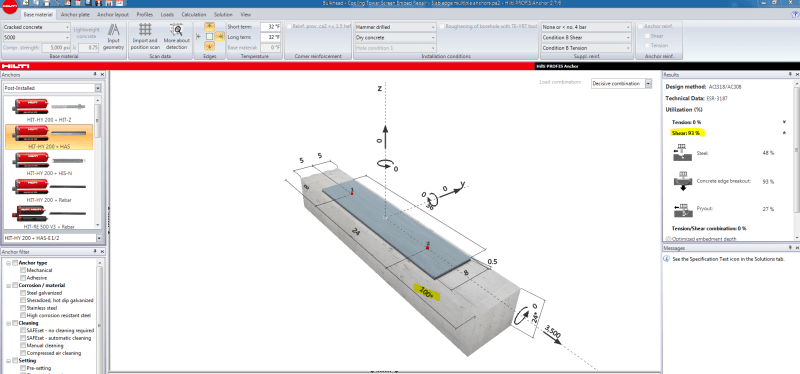I am using Profis to check an anchor design and came across something in the code that seems confusing.
The application is a shear force applied along a concrete slab edge, but you could draw a parallel to any wood or light gage shear wall anchored to the top of a concrete stem wall. The force direction and anchor layout would be similar.
If you evaluate the capacity of a single anchor in this application, it might come in at around 3,000 lbs limited by the breakout strength of concrete. However, I found when adding more anchors the capacity does not increase. Reading through Appendix D of the ACI 318-11, this is consistent with the code equations. I believe this is because the factor Avc in section D.6.2.1 does not increase as you add anchors further down the row.
My questions are:
1) By spacing anchors further apart, do you eliminate the "group action" so that you can base the design of the line of anchors on the individual capacity x number of anchors? At what spacing would you consider this to be an option?
2) The equations (and software) indicate that if you have no nearby edges the force would be based on the "parallel to edge" condition of D.6.2.1(c), which is twice the capacity of an anchor loaded perpendicular to the edge. At what edge distance would you consider there to be no breakout effects? See the 2 attached screenshots from Hilti showing an infinite edge distance with double the capacity of a 100" edge distance.
The application is a shear force applied along a concrete slab edge, but you could draw a parallel to any wood or light gage shear wall anchored to the top of a concrete stem wall. The force direction and anchor layout would be similar.
If you evaluate the capacity of a single anchor in this application, it might come in at around 3,000 lbs limited by the breakout strength of concrete. However, I found when adding more anchors the capacity does not increase. Reading through Appendix D of the ACI 318-11, this is consistent with the code equations. I believe this is because the factor Avc in section D.6.2.1 does not increase as you add anchors further down the row.
My questions are:
1) By spacing anchors further apart, do you eliminate the "group action" so that you can base the design of the line of anchors on the individual capacity x number of anchors? At what spacing would you consider this to be an option?
2) The equations (and software) indicate that if you have no nearby edges the force would be based on the "parallel to edge" condition of D.6.2.1(c), which is twice the capacity of an anchor loaded perpendicular to the edge. At what edge distance would you consider there to be no breakout effects? See the 2 attached screenshots from Hilti showing an infinite edge distance with double the capacity of a 100" edge distance.

